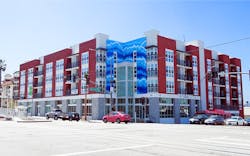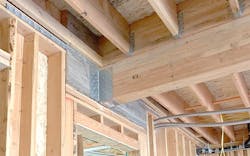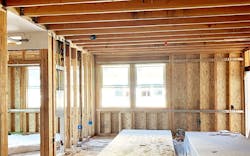Las Ventanas: A Window into Affordability
To help address the local homelessness crisis, Long Beach, California, enacted the “Everyone Home Long Beach” plan—an initiative that encouraged innovative, low-income housing solutions for the community. The plan sparked the bold vision for the development of a modern, affordable housing complex. Dubbed Las Ventanas, which means “the windows,” it’s a fitting name for a project that provides new windows of opportunity to low-income residents seeking housing options.
Set on just over an acre off the Pacific Coast Highway, the 148,000 total sq. ft. complex features 102 residential units with 3,962 square feet of retail space and a semi-subterranean podium parking garage. True to the name “Las Ventanas,” the apartments offer naturally lit, open floor plans with patios or balconies. On-site amenities include a children’s play area, outdoor seating with grilling space, locked bicycle storage, computer lab, community room, media center and more.
The four-story apartment complex was designed by William Hezmalhalch Architects (WHA) and CORE Structure Inc.—though AMCAL General Contractors also was involved during the early design stage. With a modest $28 million budget, it was critical the team used creative and strategic planning for construction.
“It was vital that all the window openings remained true to the original design presented to the community, so determining shear wall locations and minimizing hold-downs was my primary coordination with CORE Structure,” said Bernard Ines, architect with WHA.
Las Ventanas integrates traditional wood framing with engineered wood products from APA members Norbord, Tolko, Boise Cascade, Pacific Woodtech and Rosboro. Oriented strand board (OSB) and plywood continuous sheathing on the walls, floors and roof served as an integral part of the structure’s lateral force-resisting system. Glued-laminated beams and laminated veneer lumber (LVL) were used as headers, and LVL was used widely as rim joists throughout the structure.
Shear Wall Analysis Offers a Window of Opportunity
Working within the budget, the design team saw that they could take advantage of the continuously sheathed exterior walls by designing the shear walls for force transfer around openings (FTAO). With FTAO, the design team was able to reduce the number of hold-downs and material costs while maximizing window openings—an apt goal for a building named “Las Ventanas.”
“We tried to make it as affordable as possible,” said Tavallali. “We were able to reduce the number of hold-downs by 30% to 40%. We also used straps instead of the typical tie-down rods to transfer tension from floor to floor, which made labor and construction easier.”
Why FTAO? The Force Transfer Around Opening (FTAO) method of shear wall analysis provides more design flexibility as it allows for narrower wall segments to meet required height-to-width ratios. Traditional segmented shear wall design ignores any sheathing used above or below a window opening. When continuously sheathing a building, FTAO deflection equations account for the additional stiffness provided by wood structural panels below the openings, thereby reducing the calculated building drift. FTAO can also reduce the number of hold-downs required, reducing material costs.
Engineers Find Answers in Engineered Wood
When a challenge arose with the plan, the designers found a cost-effective solution using engineered wood framing. Due to the sloped site, the top of the post-tensioned concrete podium was intentionally elevated at the retail spaces on the uphill side, so the floor on the third level included areas of both concrete and wood construction. The wood shear walls above did not align with the concrete walls below, presenting a unique challenge.
Read how designers used engineered wood to solve this challenge and find additional details and images in the full case study available as a free download at www.apawood.org.
APA Social Media:
LinkedIn: https://www.linkedin.com/company/apa---the-engineered-wood-association/
Facebook: https://www.facebook.com/APAEngineeredWood
Twitter: https://twitter.com/APAwood


